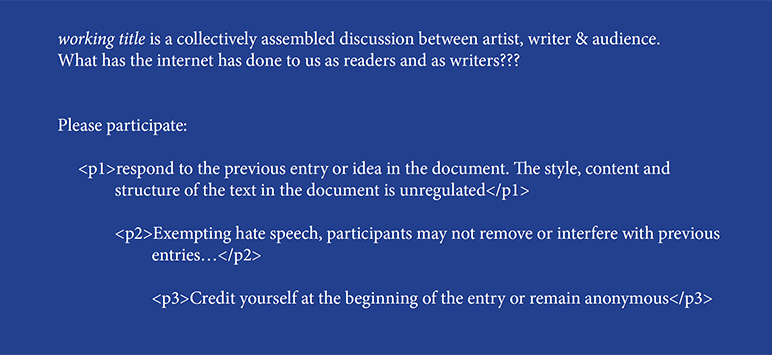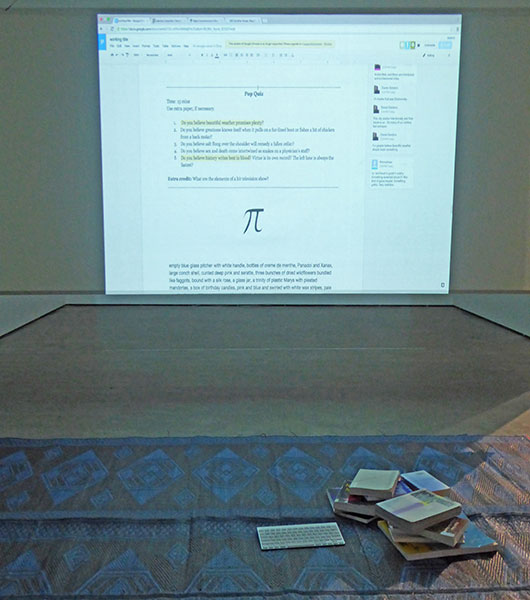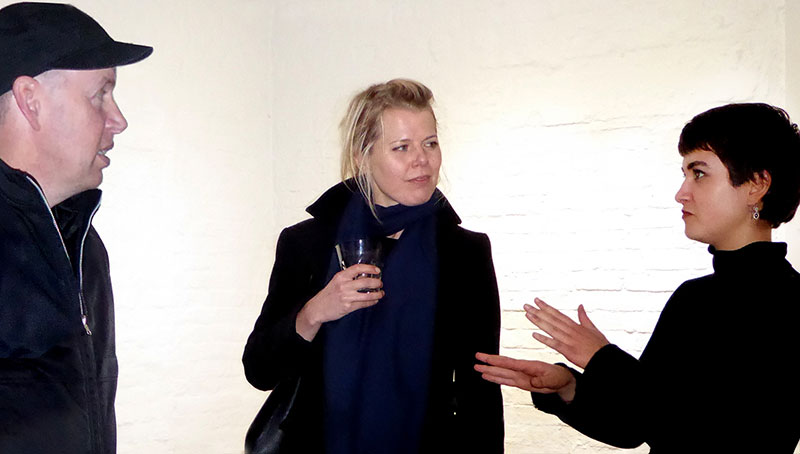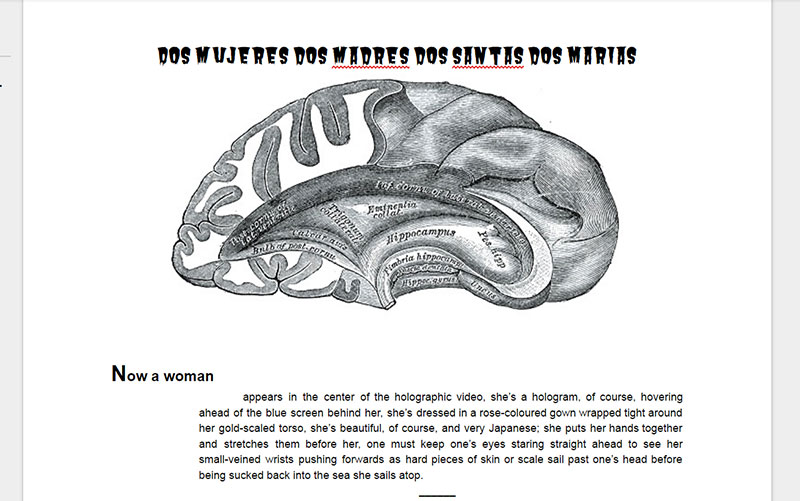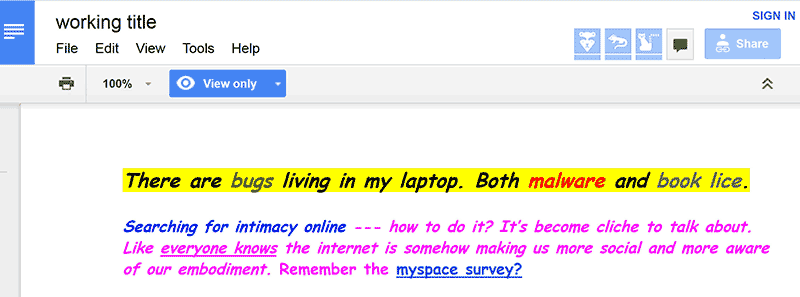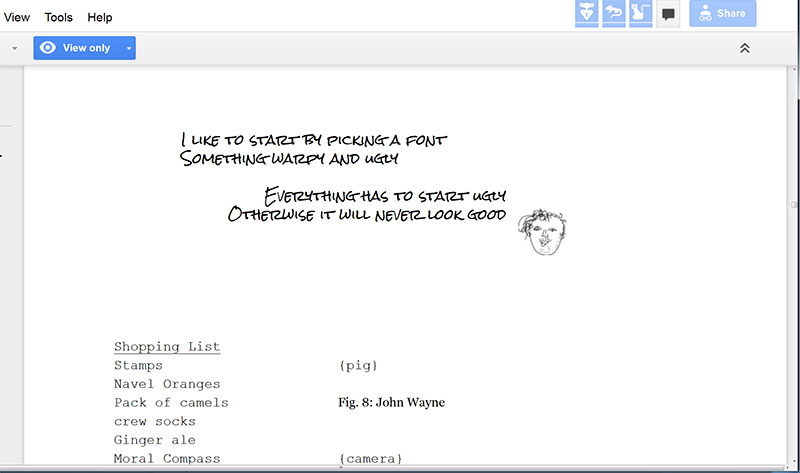For five days in early June, Bianca Rocca (Fine Arts Honours student) and Toyah Webb (English Honours student) offered an opportunity to explore this question experientially by participating in an open and collaborative google doc. Their project, working title, was billed as a collectively assembled discussion between artist, writer and audience.
Invitations to participate and to attend opening and closing events flowed out via the Elam School of Fine Arts network and Elam Galleries’ Facebook page. CLeaR sent an alert to its mailing list on behalf of the new student-led journal of cross-disciplinary writing io. Beautifully presented posters and flyers accompanied the invitations. 95 BFM (Auckland’s student radio station) interviewed Toyah and Bianca for their “Who arted” programme …and that’s just what I found out about! It struck me that, as a side-effect, these opportunities to gain experience in marketing would stand Bianca and Toyah in good stead in any future career.
You can follow the project’s progress on its Facebook page and/or view the final document online.
Opening and closing events were held at Elam’s George Fraser Gallery. In between, the gallery provided a venue to participate, observe or just relax and browse the physical books Bianca and Toyah had thoughtfully provided.
The opening event promised a panel discussion with Drs Stephen Turner and Evija Trofimova. As people trickled in, Stephen and Evija sought inspiration for their talk, chatting with Toyah and Bianca, scanning the posters and the document to date and perusing the piles of books scattered around.
Stephen and Evija’s improvised performance was erudite, thought-provoking and sometimes whimsical. Their musings meandered from literature as we have known it to a discussion of the opportunities (or challenges) the machine offers. In passing, they doffed a hat to Jonathan Swift, whose A Tale of a Tub, illustrates that such ruminations are nothing new. While I confess that at times I lost the thread as I strained to hear in the echoing chambers of the gallery, I’ll try to give a taste of the evening by paraphrasing the talk. After all, if I get it wrong, Stephen and Evija have the right of reply (by comment), another effect the internet has had on our writing.
In order to think about what the internet is doing to our writing and reading, we need to think about what we were doing before. Playing on the ‘exquisite cadaver’ motif, Stephen mused on the ‘corpse’ of writing as we knew it. For example, over the last few centuries, we have thought of literature as a window that you looked through not on the world, but on the soul of human beings. The romantic age talked about nature as a sort of presence all around you. Our nature is the internet and its presence is increasingly universal and inescapable. You do something with it and it feeds back. It will develop on the basis of what has gone into it, so it’s alive in a sense. We’re all subject to this now. Technology has enabled us to view literature more as a storage facility for social information. Even as a scholar, there is a limit to the number of books you can read from a period in literature. A machine, however, can take it all and run it through an algorithm that will throw up all sorts of things that you didn’t understand.
The machine offers multi-modal opportunities. Writing might now be viewed as a series of functions. Writers explore the functions a program offers to create new designs. Stephen said, “When I think about style, it’s not any longer, “Oh, I’m going to write like Joyce”, or “I’m going to develop my own individual style.”” When you look at this poster, you can see a lot of design decisions have been made on things like colour, font and layout’ It really stylish . Digital style is a constellation of elements. Now when we do something, our sense of style, our sense of play, our creativity are all involved even though we’re playing with functions.”
We have also seen the rise of authorless writing. (Sometimes it can be difficult to know just who that bureaucratic edict came from!) Machines offer feedback based on algorithms. This ranges from grammar and spelling correction to the machine identifying previously unrecognised templates that it sees as likely to achieve success or popularity. Stephen acknowledged the machine’s limitations in recognising the intent of the creator, but did not seem to view the ascendance of artificial intelligence as creator negatively, even in the realms of poetry and drama.This embracing of Artificial Intelligence as just another stage in an evolving journey evoked some passionate discussion in the second part of the ‘event’ when the audience crowded around the walls of the room housing a projection of the document to date. Someone suggested that some of the content (eg the dramatic script) on the working title document had been written by artificial intelligence. Another questioned why, speaking to a group of creative people, Stephen was so willing to ‘subsume creativity in the machine’. She laid down a challenge: The idea of algorithms and that everything is a template, a ‘pre-pack, digested and thrown into the world’ will produce something that will sell and bring profit but aren’t you the people responsible for fostering creativity in new and unusual forms beyond templates and algarithms?
Bianca says that most of the people who attended the event contributed to the google doc the next day. It was a thought-provoking debate and one we would like to see continued here.
As you would expect from a document based on a game (exquisite corpse) that surrealists and Dadaists enjoyed, the final document plays with styles – literary and artistic. A variety of fonts, colours, highlighting and images intermingle exuberantly with prose, poetry, drama, song lyrics, limericks, commentary,,, the list goes on. I’ve posted some screenshots from the document below as a taster, but it doesn’t do it justice. Check the final document out!
